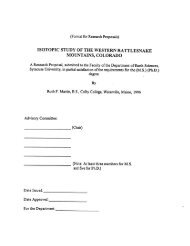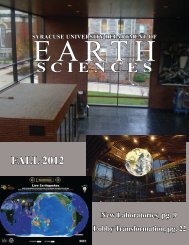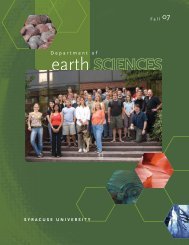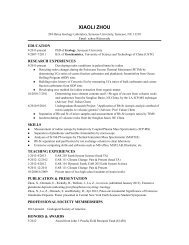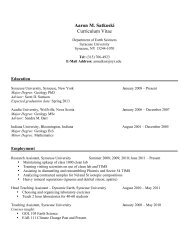alumni reception - Syracuse Universe Department of Earth Sciences ...
alumni reception - Syracuse Universe Department of Earth Sciences ...
alumni reception - Syracuse Universe Department of Earth Sciences ...
Create successful ePaper yourself
Turn your PDF publications into a flip-book with our unique Google optimized e-Paper software.
Course on “World Water”, and will be teaching a new<br />
large lower division course on “The Science <strong>of</strong> Water”<br />
for the A&S curriculum. I plan to take undergraduate<br />
students to China in May 2011 to see firsthand the<br />
major water problems that nation has to deal with.<br />
Finally, I insist on mentioning that last May,<br />
I took a comprehensive exam in the culinary arts at<br />
the Sichuan Institute <strong>of</strong> Higher Cuisine in Chengdu.<br />
There, I was the first westerner invited to give a<br />
Chinese-style cooking demonstration to the master<br />
chef <strong>of</strong> the Institute. Video <strong>of</strong> the demo will be on<br />
Youtube sometime in the fall. The Institute’s master<br />
Chef commented that my knife skills were excellent,<br />
and that my presentation and order <strong>of</strong> cooking in<br />
the massive wok were fine. As to the taste, the Chef<br />
was sufficiently satisfied to invite both Bette and me<br />
(for baking) to give a set <strong>of</strong> presentations on western<br />
cooking. My appraisal was a “C” grade--but I passed!<br />
Bruce Wilkinson<br />
This past year, I became a paleontologist. For<br />
the past couple <strong>of</strong> decades, I have been making light<br />
<strong>of</strong> stratigraphic types who see “cycles” in sedimentary<br />
successions (Emperor’s New Clothes). One way<br />
to look at the issue is to measure vertical distances<br />
between supposed cycle bottoms (e.g. sandstone bases<br />
<strong>of</strong> Carboniferous “cyclothems”). If indeed periodic,<br />
then distances should look like waiting times at a bus<br />
stop; regular recurrences in space or time. But, it<br />
turns out that “cycle” recurrence is largely random;<br />
cycle base separations are unpredictable, like the<br />
durations between goals in a World Cup soccer match<br />
turns out that patches <strong>of</strong> different carbonate facies<br />
across a depositional region like the Persian Gulf or<br />
the Bahamas is also well-described as being largely<br />
random; areas <strong>of</strong> patches are much like the pieces <strong>of</strong><br />
a broken plate; lots <strong>of</strong> small pieces, relatively few big<br />
areas. Sizes <strong>of</strong> countries look exactly the same.<br />
This all bears on paleontology because<br />
numbers <strong>of</strong> smaller fossil groups belonging to larger<br />
fossil groups (taxonomic membership frequencies)<br />
exhibit exactly the same distributions; groups with<br />
fewer numbers <strong>of</strong> subtaxa are more common than<br />
those with more subtaxa. Why should a broken plate<br />
model <strong>of</strong> random division <strong>of</strong> geographic depositional<br />
area also serve to describe taxonomic memberships?<br />
The reason may be that taxonomic identity (e.g.<br />
Mammalia, Primates, Hominidae, Homo sapiens) is<br />
dependent on morphological attributes; on the basis<br />
<strong>of</strong> what an organism looks like. Just as depositional<br />
surfaces are partitioned among different facies, the<br />
division <strong>of</strong> biologic morphospace serves as the basis<br />
<strong>of</strong> classification for various organisms. Fun stuff.<br />
Taxonomic membership distributions resemble the<br />
distribution <strong>of</strong> fragments <strong>of</strong> a broken plate.<br />
or the decay <strong>of</strong> radioactive elements; lots <strong>of</strong> short<br />
durations, few relatively long waiting times. That<br />
brings up the related question: if vertical stratigraphic<br />
distances are random, what do horizontal areas <strong>of</strong><br />
sediment on modern surfaces look like? Well, it



